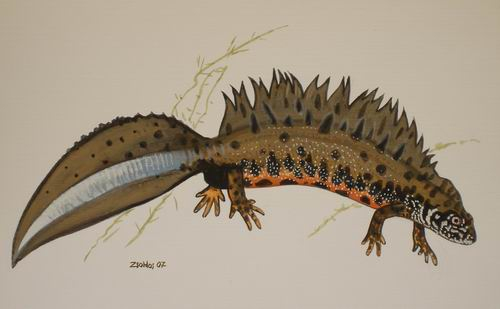Facts About Danube crested newt
The Danube crested newt, often referred to as the Danube newt, is a captivating amphibian primarily found in Central and Eastern Europe. This species thrives along the Danube River basin, its tributaries, and the Dnieper delta. Unlike other crested newts in its genus, the Danube crested newt has a more slender, petite build. During the breeding season, males develop a distinctive jagged crest along their back and tail, making them quite a spectacle.
These newts prefer slow-moving river margins, lakes, and ponds for breeding. Outside of the breeding season, they migrate to shady forests and other terrestrial habitats. Although they are not currently classified as threatened, their numbers have been dwindling due to habitat loss, prompting their protection under various European Union laws.
Initially, scientists considered the Danube crested newt a variety of the northern crested newt. However, further studies have confirmed it as a distinct species within the crested newt group. Interestingly, the northern crested newt remains its closest relative. While two subspecies of the Danube crested newt were once hypothesized, genetic research has since refuted this notion.
In terms of appearance, the Danube crested newt is the smallest of the crested newt species, measuring between 13-15 centimeters in length. They have streamlined bodies ideal for swimming, characterized by dark brown backs and sides, bright orange to red bellies, and distinctive black spots. During the breeding season, males display an impressive crest along their backs and tails.
These newts inhabit three distinct regions across Europe, occupying diverse environments ranging from river systems to forests. They have an extended aquatic phase, migrating to breeding sites in early spring. Males perform elaborate courtship dances to attract females, eventually depositing spermatophores for fertilization. Females then lay around 200 eggs individually on aquatic plants. The larvae take about two to four months to metamorphose into juvenile newts. Primarily nocturnal, Danube crested newts feed on invertebrates.
Despite their resilience, these newts face several threats, including habitat destruction, hybridization with other species, and the impacts of climate change. Conservation efforts are underway, with various laws and directives offering protection by prohibiting activities such as capture, killing, and habitat destruction. The International Union for Conservation of Nature (IUCN) lists the Danube crested newt as "near threatened" due to their declining populations and the ongoing challenges they face.

 Hungary
Hungary